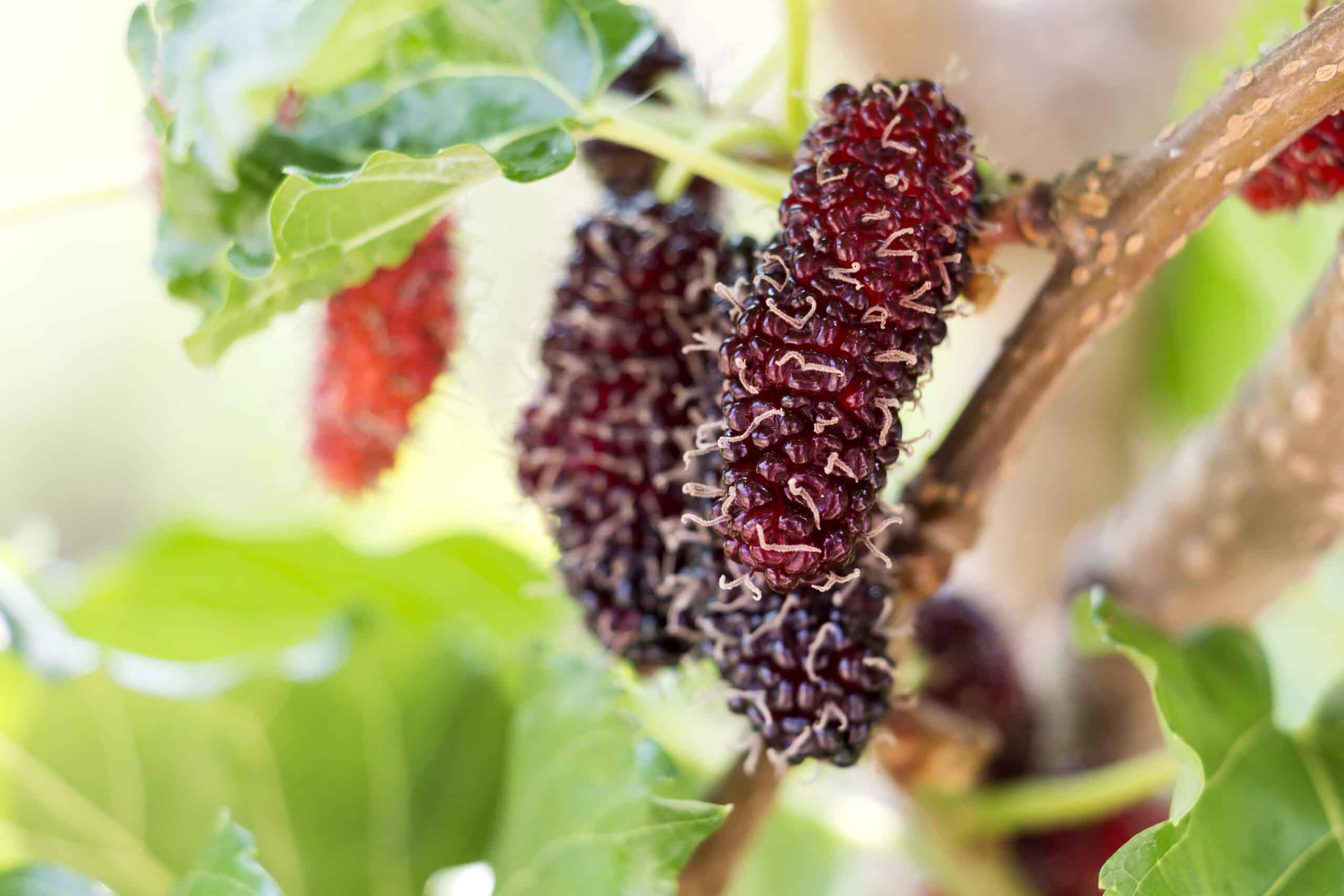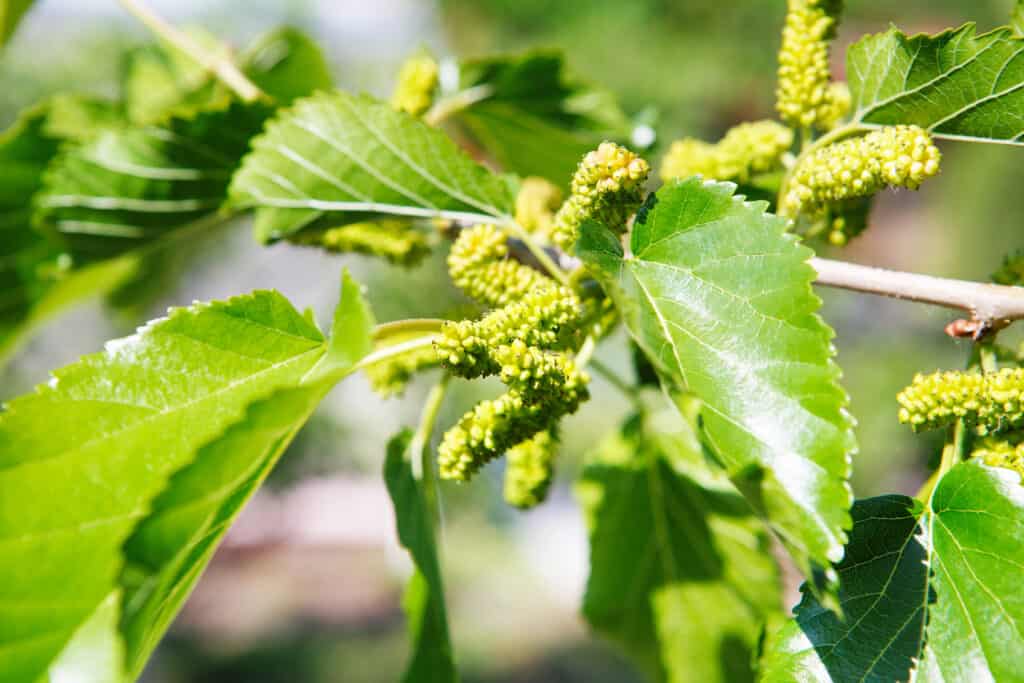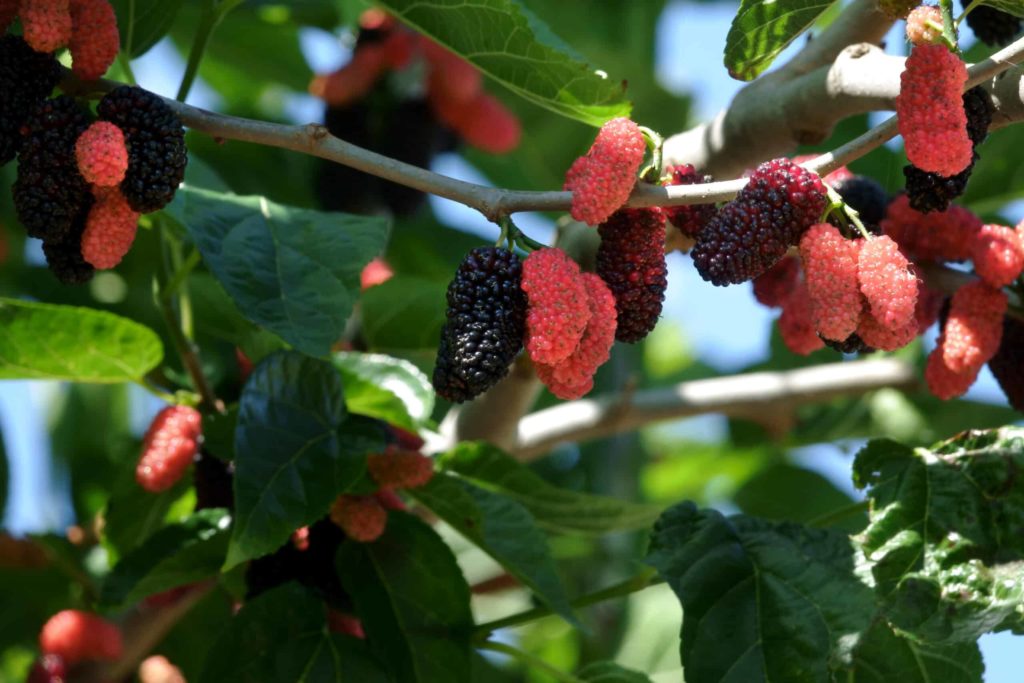Mulberries look like blackberries, but they grow on a tree, not a bush. Mulberries are not difficult to grow once established.
There are three kinds of mulberry trees: black, red, and white.
Black mulberry fruit is large, 1 to 2 inches long, and juicy; they have an intense sweet-tart flavor. The tartness of black mulberry is reminiscent of grapefruit. Black mulberries are considered the best tasting.
Red mulberries taste almost as good as black mulberries; they are about the same size.
White mulberries are smaller than black or red mulberries. They are far sweeter than either black or red mulberries, almost honey flavored with no hint of tartness.

The botanical name for the black mulberry is Morus nigra; the botanical name of the red mulberry is Morus rubra; the botanical name of the white mulberry is Morus alba.
The color of the mulberry fruit does not identify the mulberry species. White mulberry trees can produce white, lavender, or black fruit. Red mulberry trees produce deep red or almost black fruit. Black mulberry trees produce black fruit.
Mulberries can be eaten fresh out of hand or they can be used like other berries to make pies, tarts, puddings, or sweetened and pureed as a sauce. Slightly unripe mulberries fruits are best for cooking in pies and tarts. Mulberries blend well with other fruits, especially pears and apples.
Choosing a mulberry tree
- Choose a mulberry tree that will grow in your region and fit into your garden.
- Black mulberry trees grow in USDA hardiness zone 6b and warmer. They are the least cold-tolerant. Black mulberries grow 30 feet tall and about 35 feet wide; some cultivars grow shorter; they are the smallest mulberry and can produce fruit for more than 100 years.
- Red mulberry trees grow best in USDA zones 4 to 8. They grow 35 to 50 feet tall and wide. Red mulberry trees can live for about 75 years.
- White mulberry trees are the most cold-tolerant; they grow in USDA zones 3b through 9. White mulberry trees grow 30 to 80 feet tall and wide. They are the fastest-growing mulberry. White mulberries can live for about 75 years.
- Mulberries are deciduous trees; they drop their leaves in autumn.
- White mulberries leaf out in spring, about two months before black and red mulberries.
Where to plant a mulberry tree
- Grow mulberries in full sun. Trees will bear fruit in partial shade but the flavor and yield will not match plants grown in full sun.
- Plant mulberries in compost-rich, well-drained soil with a soil pH between 5.5 and 7.0. Mulberries will adapt to almost any soil, but they will struggle in wet soil.
- Avoid planting mulberries where falling fruit will hit sideways or patios. The fruit will not stain but fallen fruit is messy and will stick to shoes.
- Mulberries can withstand wind; some cultivars can be used as windbreaks.

Mulberry pollination
- Mulberries are self-pollinating they do not need cross-pollination.
- Most mulberries are wind-pollinated.
- Some mulberries set fruit without pollination.
Spacing mulberry trees
- Space mulberries 35 to 50 feet apart. Trees can grow 35 to 50 feet tall and wide.
- Space dwarf varieties 8 feet apart and semi-dwarf varieties 10 to 12 feet apart.
Planting a mulberry tree
- Plant bare-root trees in early spring as soon as the soil can be worked while the trees are still dormant.
- Plant container-grown or balled and burlapped trees in spring or early summer before hot, dry weather comes. In mild-winter regions, mulberry trees can be planted in the fall.
- Prepare a planting site in full sun that is sheltered from a prevailing breeze or wind.
- Work well-rotted compost or manure into the soil.
- Dig a hole half again as deep and twice as wide as the tree’s roots. Add a cupful of all-purpose fertilizer to the bottom of the hole.
- Put a tree stake in place before planting. Drive the stake into the ground to the side of the hole to be at least 2 feet deep.
- Set the plant in the hole so that the soil mark from the nursery pot on the stem is at the surface level or an inch or two deeper than the surrounding soil. Remove all twine and burlap from balled and burlapped trees. Spread the roots out in all directions.
- Re-fill the hole with half native soil and half aged compost or commercial organic planting mix; firm in the soil so that there are no air pockets among the roots. Water in the soil and create a modest soil basin around the trunk to hold water at watering time.
- Secure the tree to the stake with tree ties.
- After planting, water each tree thoroughly and fertilize with a high-phosphorus liquid starter fertilizer.
Container growing a mulberry
- Most mulberries grow large and are not well-suited for container growing.
- Choose a dwarf variety for container growing. There are dwarf black mulberry cultivars.
- Planted mulberries in containers 24 inches wide and deep. Repot plants every year or two as necessary to keep plants from becoming root-bound.
Mulberry care, feeding, and watering
- Keep the soil where young mulberry trees are growing evenly moist; do not let the soil dry out.
- Mulberries are drought tolerant but it the soil becomes too dry fruit will drop before it ripens.
- Fertilize established mulberries once a year in mid to late spring with a 10-10-10 organic fertilizer.
- Mulch with aged compost in autumn; winter rain will carry nutrients down into the soil.
Training a mulberry tree
- Mulberries commonly have an upright growing habit. Seedlings are usually sold as branchless whips. They are commonly trained to a central leader or modified central leader form.
- At planting time in spring: Starting with a whip, cut off the central leader with an angled cut just above a bud at about 5 feet high. If the seedling has lateral branches, remove any laterals lower than 18 inches; prune back remaining laterals by half.
- The first summer: cut back main laterals to about 8 inches from the start of this year’s growth; cut to buds that ace outward; cut back new shoots or lateral to about 6 inches; leave the central leader untouched.
- Second spring after planting: cut back the central leader to about one-third of last year’s growth.
- Following springs: cut back the central leader by two-thirds of the last year’s growth until it reaches maximum height. Cut out any dead, damaged, or diseased wood. Remove old, unproductive growth to clear congestion at the center of the tree. Tip prune the central leader to about 1 inch of the previous year’s growth. Prune for shape.

Pruning a mulberry tree
- Mulberries that have been trained to a sturdy framework will require only light pruning each year.
- Mulberries set fruit on growing shoots and on spurs on older wood.
- Prune away dead, diseased, and broken branches. Also selectively remove new shoots that crowd the center of the tree.
- Mid-summer prune sub-lateral branches growing off of structural limbs to six leaves; this will help create short, fruiting spurs.
- Prune weeping mulberries to accentuate their weeping habit.
Propagating mulberries
- Propagate mulberries from softwood cuttings which root and transplant easily. Take softwood cuttings in midsummer and treat them with a rooting hormone.
- Mulberries can be propagated by seed or grafting. Plants propagated from seed will take about 10 years to bear fruit.

Harvesting and storing mulberries
- White and red mulberries are ready for harvest in late spring.
- Black mulberries ripen in summer.
- Mulberries on a single tree will ripen over several weeks.
- Spread a tarp or sheet under the tree and shake the branches until ripe berries fall. Ripe white and red mulberries will fall readily; black mulberries may need to be cut from the tree. The juice of red and black mulberries can stain hands and clothing.
- Unwashed mulberries will keep in the refrigerator for several days if placed in a covered container.
- Mulberries can be frozen after shortly after harvest.
- Fresh ripe mulberries can be eaten out of hand or added to fruit salads or fruit cups.
- Nearly ripe mulberries which will be slightly tart can be used to make pies and tarts or jam and jelly.
Mulberry pests, diseases, and problems
- Mulberries are commonly free of pests and diseases.
- Birds eat ripe fruit and may drop the seeds resulting in new trees.
- Mulberry “popcorn disease” is a fungal disease that can cause the fruit to swell and look like popcorn. White mulberries are most susceptible to this disease which usually strikes in spring or early summer. Infected fruits and dropped fruits should be placed in the trash so that the disease does not carry over to the next year. Spraying with Bordeaux mixture may slow the disease—if the entire tree can be sprayed.
Mulberry varieties to grow
- ‘Black Persian’: black mulberry; large black fruit more than an inch long; juicy, rich, subacid flavor; the tree is drought-resistant once established.
- ‘Collier’: cross between a white and red mulberry; medium size fruit a bit more than one inch long; sweet flavor with a trace of tartness; ripens over a long period; medium size, spreading tree.
- ‘Geraldi Dwarf’: white mulberry; very good flavor; compact tree.
- ‘Illinois Everlasting’: cross between a white and red mulberry; black, nearly seedless fruit, about 12 ounces; very sweet flavor; considered the best mulberry by many growers; matures over a long period; the tree is somewhat dwarfed.
- ‘Kaester’: black mulberry; large black or deep purple fruit to 1½ inches long; sweet-tart flavor balance; the tree bears heavily.
- ‘Kokuso’: white mulberry; firm fruit with very good flavor; the tree grows low and wide; very cold hardy; ripens early with short harvest time.
- ‘Oscar’: white mulberry; flavor rivals black mulberry; wide, spreading tree.
- ‘Pakistan’: red mulberry; very large ruby-red fruit to 3½ inches long; firm flesh; sweet with a balance of flavor; spreading tree; recommended for South and mild-winter regions; produces well in cooler regions.
- ‘Riviera’: black mulberry; deep purple-black fruit to 1½ inch long; slightly juicy flesh, sweet taste; good dessert quality; ripens over long period mid-spring to summer.
- ‘Russian’: black mulberry; reddish-black fruit; good quality fruit; bushy tree; very hardy and drought-resistant; often used for windbreaks and wildlife food.
- ‘Shangri-La’: black mulberry; large black fruit; recommended for USDA Zones 7 to 9; large tree.
- ‘Sweet Lavender’: white mulberry; white, pink, and lavender berries; firm and juicy fruit; tree is fast growing and drought tolerant; self-pollinating; ripens mid-spring into summer; grows well in containers.
- ‘Tehana’ (‘Giant White’): white mulberry; very large, white fruit to nearly 3 inches long; very sweet, succulent, melting flesh; best in mild winter regions.
- ‘Wellington’: black mulberry; cold-hardy; recommended for East; sweet, blackberries; harvest over several weeks; the tree grows 15 to 20 feet tall.
Also of interest:
Related articles:
Planning the Home Fruit Garden
Garden Planning Books at Amazon:
- Vegetable Garden Almanac & Planner
- Kitchen Garden Grower’s Guide Vegetable Encyclopedia
- Vegetable Garden Grower’s Guide
- Tomato Grower’s Answer Book
More fruit-growing articles:
Learn how to plant, grow, prune, and harvest your favorite fruits. Click below for all you need to know.
- Apple
- Apricot
- Avocado
- Banana
- Blackberry
- Blueberry
- Cantaloupe
- Chayote
- Cherimoya
- Cherry
- Citrus
- Clementine
- Cranberry
- Currants
- Elderberry
- Feijoa
- Fig
- Gooseberry
- Grape
- Grapefruit
- Guava
- Kiwifruit
- Kumquat
- Lemon
- Lime
- Loquat
- Mandarin
- Mango
- Melon
- Mulberry
- Muskmelon
- Nectarine
- Olive
- Orange
- Papaya
- Passion Fruit
- Peach
- Pear
- Persimmon
- Pineapple
- Pineapple Guava
- Plantain
- Plum
- Pomegranate
- Pumpkin
- Quince
- Raspberry
- Strawberry
- Tangelo
- Tangerine
- Tangor
- Watermelon















